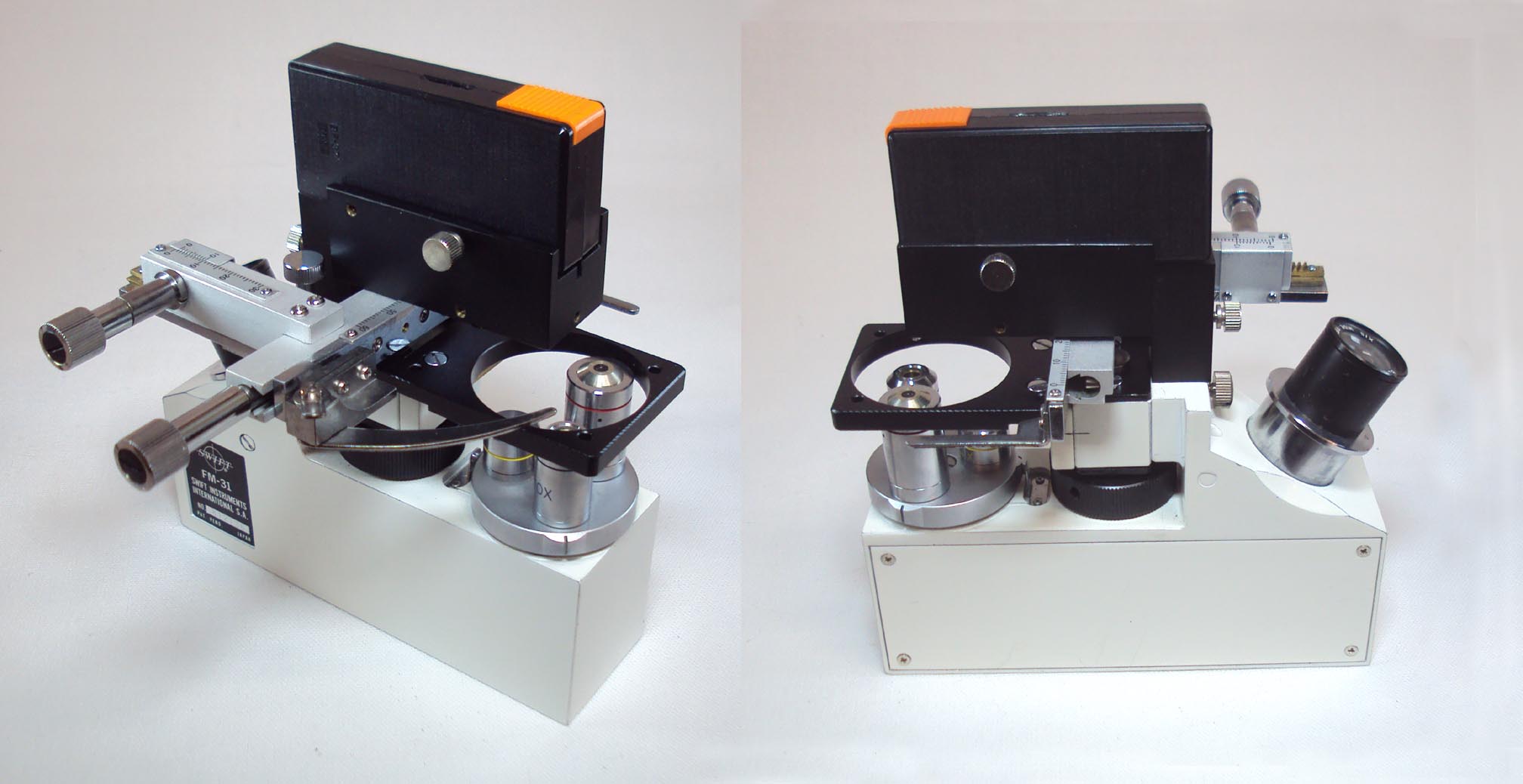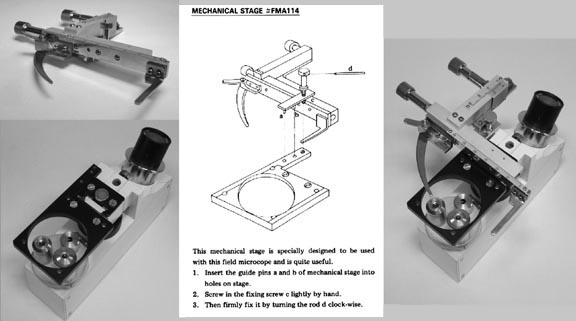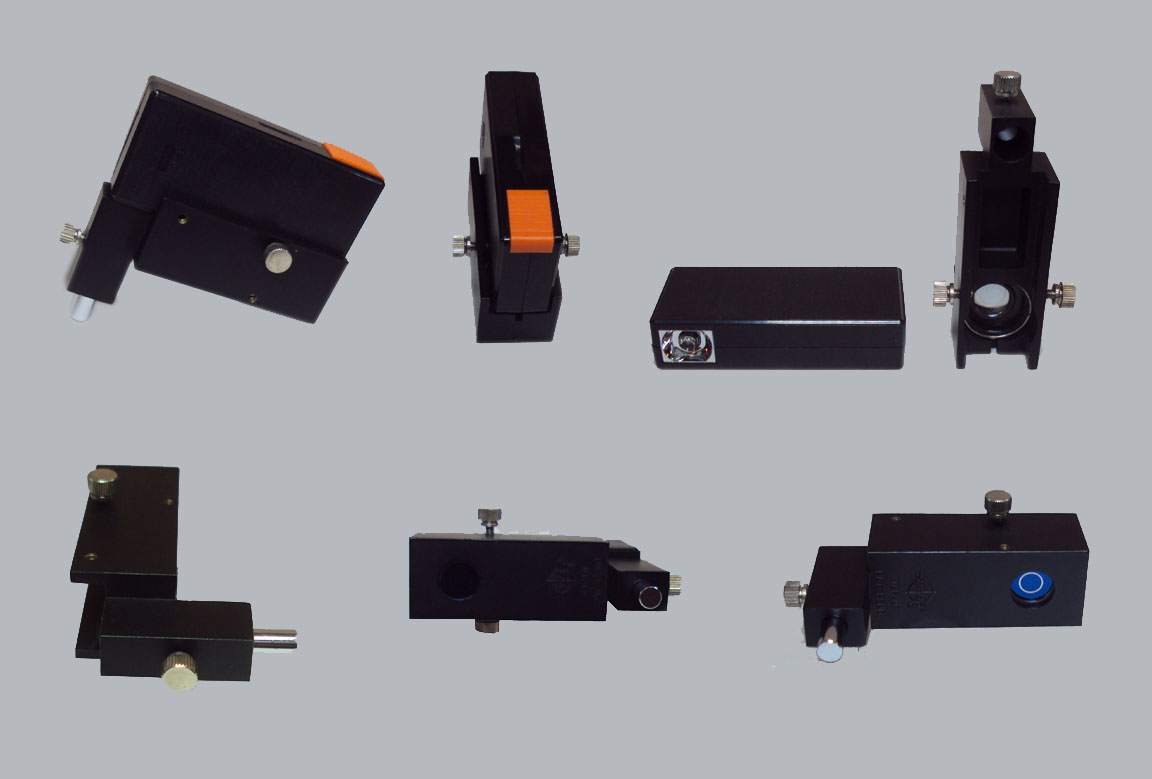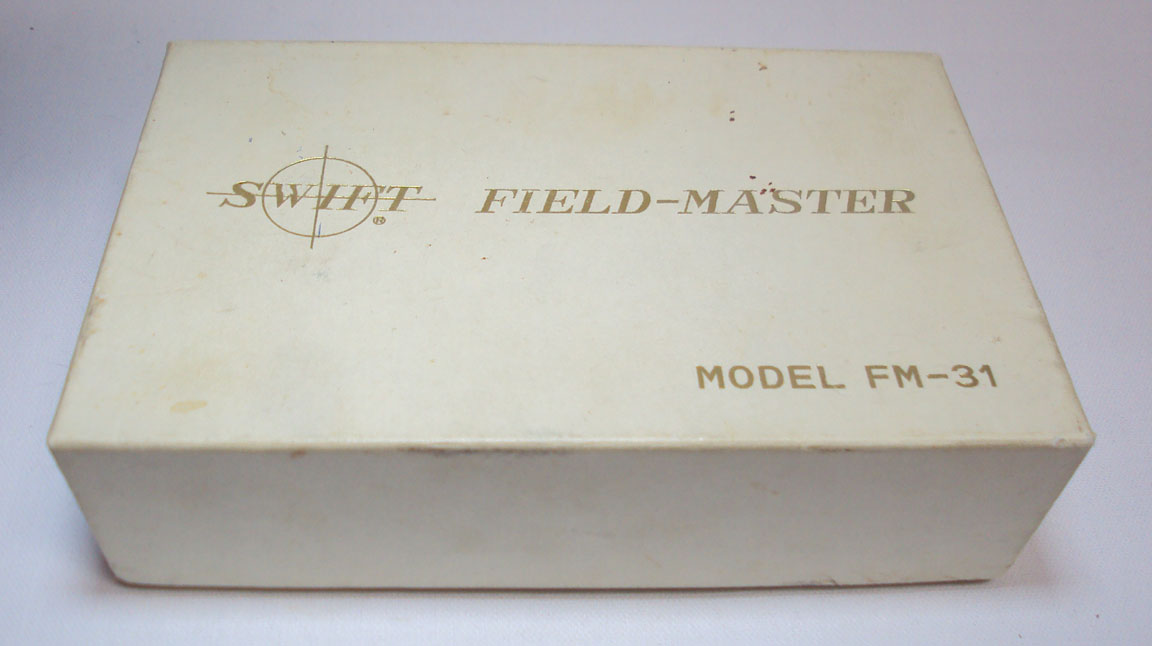MICROSCOPE-ANTIQUES.COM © 2013-15.
FM-31 PORTABLE COMPOUND MICROSCOPE
MODEL: 'FIELD-MASTER or FM-31'
C. 1980
SIGNED: 'SWIFT, FM-31, SWIFT INSTRUMENTS, INTERNATIONAL S.A. NO. 812436, PAT. PEND. JAPAN'
SERIAL NUMBER: 812436

DESCRIPTION:
 The 'Field Master' or 'FM-31' was originally sold in the configuration seen in my example. Unlike the prismatic construction of
McArthur's instruments, the FM-31 uses mirrors. It also has its eye tube angled so that the microscope does not need to be tilted in use, an improvement.
The body is made of aluminum alloy but is still quite a bit heavier than the McArthur. It is also larger.
Unlike the McArthur's sliding objective plate, the Swift uses a revolving nosepiece akin to most traditional modern microscopes.
It still uses special small objectives. The draw tube locks into position when extended and twisted, another improvement. The black
knurled focusing wheel is a vertically actuating mechanism and works very well.
The 'Field Master' or 'FM-31' was originally sold in the configuration seen in my example. Unlike the prismatic construction of
McArthur's instruments, the FM-31 uses mirrors. It also has its eye tube angled so that the microscope does not need to be tilted in use, an improvement.
The body is made of aluminum alloy but is still quite a bit heavier than the McArthur. It is also larger.
Unlike the McArthur's sliding objective plate, the Swift uses a revolving nosepiece akin to most traditional modern microscopes.
It still uses special small objectives. The draw tube locks into position when extended and twisted, another improvement. The black
knurled focusing wheel is a vertically actuating mechanism and works very well.
 The stage can be fitted with stage clips, or as seen
here in my example, with a purpose-made full mechanical stage. The mechanical stage has two pins plus a thumbscrew fitting into the stage
from above, and an additional tightening clamp acting against the side of the stage from the right side; this second clamp was added after the original
stage was in production for a while, apparently to increase stability.
The mechanical stage is calibrated in both the horizonal and vertical axes, and uses angled racks and pinions.
Even though the edges of the slide are held freely, without resting on the stage, this mechanical stage works
surprisingly well.
The stage can be fitted with stage clips, or as seen
here in my example, with a purpose-made full mechanical stage. The mechanical stage has two pins plus a thumbscrew fitting into the stage
from above, and an additional tightening clamp acting against the side of the stage from the right side; this second clamp was added after the original
stage was in production for a while, apparently to increase stability.
The mechanical stage is calibrated in both the horizonal and vertical axes, and uses angled racks and pinions.
Even though the edges of the slide are held freely, without resting on the stage, this mechanical stage works
surprisingly well.
 There are four objectives with my unit, including a brightfield low power and a bright field 40X, as well as phase contrast 10X and 40X objectives, though, of course
only three will fit on the nosepiece at any one time.
There are four objectives with my unit, including a brightfield low power and a bright field 40X, as well as phase contrast 10X and 40X objectives, though, of course
only three will fit on the nosepiece at any one time.
 The illuminator light source has evolved over the years.
Initially, it used an incandescent bulb in a rectangular shaped arrangement as shown here, but later a 'Mini Maglite'® was
used and then finally an LED illuminator. During the transitional period with the Mini Maglite®, the condenser arm could accept the old rectangular illuminator or the
Mini Maglite®. Once the change was made to the LED, the phase contrast and polarized light accessories were no longer
offered. The original illuminator is pictured here. My version is set up for phase contrast,
and hence has the phase contrast condenser fit under the removable light source. The light source can be centered right
to left using two
adjustment screws, one to either side, and can also be moved forward or backward after loosening these screws, hence it can be
centered exactly. The condenser arm has a metal rod projecting downward to fasten into the body of the microscope
just in front of the eyepiece. It is held in place by a single thumbscrew and its distance to the slide and objectives can therefore
also be adjusted if desired.
The illuminator light source has evolved over the years.
Initially, it used an incandescent bulb in a rectangular shaped arrangement as shown here, but later a 'Mini Maglite'® was
used and then finally an LED illuminator. During the transitional period with the Mini Maglite®, the condenser arm could accept the old rectangular illuminator or the
Mini Maglite®. Once the change was made to the LED, the phase contrast and polarized light accessories were no longer
offered. The original illuminator is pictured here. My version is set up for phase contrast,
and hence has the phase contrast condenser fit under the removable light source. The light source can be centered right
to left using two
adjustment screws, one to either side, and can also be moved forward or backward after loosening these screws, hence it can be
centered exactly. The condenser arm has a metal rod projecting downward to fasten into the body of the microscope
just in front of the eyepiece. It is held in place by a single thumbscrew and its distance to the slide and objectives can therefore
also be adjusted if desired.
 There is a thread on the bottom to accept a tripod. It was supplied with a black leather case and carrying strap, and a printed brochure of instructions.
It came in a white cardboard box with gold lettering.
There is a thread on the bottom to accept a tripod. It was supplied with a black leather case and carrying strap, and a printed brochure of instructions.
It came in a white cardboard box with gold lettering.
HISTORY OF THE FM-31: (for history of the original McArthur Microscopes please visit the McArthur Main Page
). The FM-31 microscope was first produced for the (American) Swift Company by a Japanese company under licence about 1980.
Another model, the FM-41 was a surface inspection metallurgical model.
The original focusing mechanism was the sound vertical wheel focus as seen on the instrument above; as noted below,
in later years this was changed to a 'easier to use', but less reliable
transverse focusing mechanism. Over the years
attempts were made to market the microscope for on site asbestos inspection, but the marketing apparently got ahead of the
design before the optics had been upgraded enough to identify different types of asbestos.
The scope may have found its greatest following and sales among veteranarians who were, according to the companies former president,
among the largest group of buyers.
By 2004, the focusing mechanism had been changed to the transverse focusing system which, although more traditional in
action, was much less dependable and tended to freeze up because of an inadequate stopping mechanism at the extremes of
travel.
Sometime after the Mini Maglite became available, the illuminator was changed accomodate it; at this time it also accepted the older
rectangular incandescent illuminator. The Maglite provided
a brighter light source, good for higher powers but too bright for the very lowest power 4X objective.
Sometime around 2005 an LED illuminator was developed, but left less room for specialized improvements such as
phase contrast or polarized light use and these were no longer provided once this change was made.
In 2006 the cost of the FM-31 became too great, and with lagging sales, the model was
discontinued by Swift. During the years the FM-31 was sold by Swift, the numbers of units sold averaged in the "low hundreds" per year according
to sources formerly working for Swift. Speedfair (Motic) bought out the family-owned Swift company, about July 2007
when financial pressures forced the sale. Speedfair has not, to date, attempted to sell the FM-31 since the 2007 sale. It has been revived
as a clone, (sold by Ted Pella and also by Brunel), in a configuration very similar to the last version with LED lighting. Phase contrast and polarized light versions are not currently offered,
as the LED version design does not allow for the degree of precision needed in optical alignment.
After Swift was sold, the design (with the flawed transverse focusing) continued to be produced for more than one
retailer at various prices, including Ted Pella's rather expensive version, and a less expensive but apparently very
similar model sold currently by Brunel in England, and likely others. These have the newer LED illuminator and also the
potentially troublesome, focusing mechanism, without the capability for phase contrast or polarized light work.
The new clones have been compared to the older FM-31 by Yuval Goren and R. Jordon Kreindler in their Micscape article referenced below.
The optical quality of the Swift scopes has been fairly good but was never brought up to the excellent level of the
original McArthurs due to lagging sales, but is still a bit ahead of the current clones.
The interior of the new clones is not sealed (at the tripod fitting) and the interior finish is not as good as the FM-31,
leading to some degree of internal reflection. The original FM-31 was made of an aluminum alloy, whereas the newer
clones are made of an iron alloy, with the interior prone to rust.
For much more on the history of the McArthur-type microscopes, please see my McArthur Main page.

 The 'Field Master' or 'FM-31' was originally sold in the configuration seen in my example. Unlike the prismatic construction of
McArthur's instruments, the FM-31 uses mirrors. It also has its eye tube angled so that the microscope does not need to be tilted in use, an improvement.
The body is made of aluminum alloy but is still quite a bit heavier than the McArthur. It is also larger.
Unlike the McArthur's sliding objective plate, the Swift uses a revolving nosepiece akin to most traditional modern microscopes.
It still uses special small objectives. The draw tube locks into position when extended and twisted, another improvement. The black
knurled focusing wheel is a vertically actuating mechanism and works very well.
The 'Field Master' or 'FM-31' was originally sold in the configuration seen in my example. Unlike the prismatic construction of
McArthur's instruments, the FM-31 uses mirrors. It also has its eye tube angled so that the microscope does not need to be tilted in use, an improvement.
The body is made of aluminum alloy but is still quite a bit heavier than the McArthur. It is also larger.
Unlike the McArthur's sliding objective plate, the Swift uses a revolving nosepiece akin to most traditional modern microscopes.
It still uses special small objectives. The draw tube locks into position when extended and twisted, another improvement. The black
knurled focusing wheel is a vertically actuating mechanism and works very well.
 The stage can be fitted with stage clips, or as seen
here in my example, with a purpose-made full mechanical stage. The mechanical stage has two pins plus a thumbscrew fitting into the stage
from above, and an additional tightening clamp acting against the side of the stage from the right side; this second clamp was added after the original
stage was in production for a while, apparently to increase stability.
The mechanical stage is calibrated in both the horizonal and vertical axes, and uses angled racks and pinions.
Even though the edges of the slide are held freely, without resting on the stage, this mechanical stage works
surprisingly well.
The stage can be fitted with stage clips, or as seen
here in my example, with a purpose-made full mechanical stage. The mechanical stage has two pins plus a thumbscrew fitting into the stage
from above, and an additional tightening clamp acting against the side of the stage from the right side; this second clamp was added after the original
stage was in production for a while, apparently to increase stability.
The mechanical stage is calibrated in both the horizonal and vertical axes, and uses angled racks and pinions.
Even though the edges of the slide are held freely, without resting on the stage, this mechanical stage works
surprisingly well. There are four objectives with my unit, including a brightfield low power and a bright field 40X, as well as phase contrast 10X and 40X objectives, though, of course
only three will fit on the nosepiece at any one time.
There are four objectives with my unit, including a brightfield low power and a bright field 40X, as well as phase contrast 10X and 40X objectives, though, of course
only three will fit on the nosepiece at any one time.
 The illuminator light source has evolved over the years.
Initially, it used an incandescent bulb in a rectangular shaped arrangement as shown here, but later a 'Mini Maglite'® was
used and then finally an LED illuminator. During the transitional period with the Mini Maglite®, the condenser arm could accept the old rectangular illuminator or the
Mini Maglite®. Once the change was made to the LED, the phase contrast and polarized light accessories were no longer
offered. The original illuminator is pictured here. My version is set up for phase contrast,
and hence has the phase contrast condenser fit under the removable light source. The light source can be centered right
to left using two
adjustment screws, one to either side, and can also be moved forward or backward after loosening these screws, hence it can be
centered exactly. The condenser arm has a metal rod projecting downward to fasten into the body of the microscope
just in front of the eyepiece. It is held in place by a single thumbscrew and its distance to the slide and objectives can therefore
also be adjusted if desired.
The illuminator light source has evolved over the years.
Initially, it used an incandescent bulb in a rectangular shaped arrangement as shown here, but later a 'Mini Maglite'® was
used and then finally an LED illuminator. During the transitional period with the Mini Maglite®, the condenser arm could accept the old rectangular illuminator or the
Mini Maglite®. Once the change was made to the LED, the phase contrast and polarized light accessories were no longer
offered. The original illuminator is pictured here. My version is set up for phase contrast,
and hence has the phase contrast condenser fit under the removable light source. The light source can be centered right
to left using two
adjustment screws, one to either side, and can also be moved forward or backward after loosening these screws, hence it can be
centered exactly. The condenser arm has a metal rod projecting downward to fasten into the body of the microscope
just in front of the eyepiece. It is held in place by a single thumbscrew and its distance to the slide and objectives can therefore
also be adjusted if desired.
 There is a thread on the bottom to accept a tripod. It was supplied with a black leather case and carrying strap, and a printed brochure of instructions.
It came in a white cardboard box with gold lettering.
There is a thread on the bottom to accept a tripod. It was supplied with a black leather case and carrying strap, and a printed brochure of instructions.
It came in a white cardboard box with gold lettering.